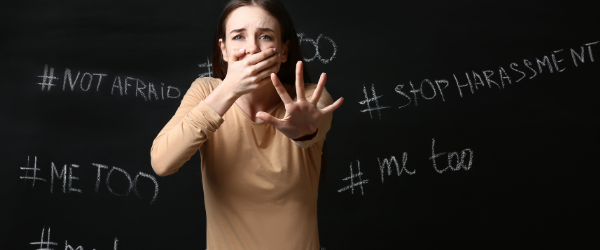How the #MeToo Movement Changed Sexual Harassment Forever

In 2006, the Me-Too movement began. It was an effort to bring awareness to sexual harassment and sexual assault across the country. Countless women began telling their stories of sexual harassment and assault at work and on college campuses. In 2017, Actress Alyssa Milano brought national attention to the movement with #MeToo across all social media platforms. Soon, everyone knew someone that had experienced some form of sexual harassment or sexual assault.
It may have happened to your mother, sister, brother, father, neighbor, uncle, aunt, best friend, or child. #MeToo allowed people from all over the world to join together in solidarity and tell the world that they would not be victims anymore. However, the movement did much more than just give victims a place to come together and know they were not alone. While that would have been sufficient, the movement brought awareness to the sexual harassment and sexual assault epidemic that plagued our workplaces and colleges.
What Is Sexual Harassment in the Workplace?
Sexual harassment in the workplace occurs when an employer or job applicant experienced unwelcomed physical contact, sexual comment, or sexual advances. Due to the #MeToo movement, people now understand that sexual harassment can come from anyone in the workplace and be subtle or blatantly obvious.
For instance, calling a woman “hon,” “honey, “sweetheart,” “baby,” or any such names, even after being asked to stop, is a form of sexual harassment. Making comments about your body, what they may want to do to or with your body, and what they may do with their body can also be sexual harassment, especially if you ask for the comments to stop. Other forms of sexual harassment can include the following:
- Repeatedly asking you on a date, even after you continue to say no
- Physically touching any part of your body when you ask them to stop
- Sharing sexual comics, jokes, or photos
- Stalking you online or in public
- Sexting
- Making obscene gestures towards you, at you, or to you
These examples are just some of the ways sexual harassment can occur within the workplace.
How Did the #MeToo Movement Bring Awareness to Sexual Harassment and Sexual Assault?
The #MeToo movement brought awareness to sexual harassment and sexual assault in several ways. First, it helped give a voice to people who had been silenced in the workplace and college campuses for too long. By voicing their experiences, they joined a rapidly growing group of men and women who experienced their own horrors. The movement brought awareness to the victims. It allowed victims to stand up and stop excusing behavior as the norm.
Many people began to question if something they thought was just normal activity was actually sexual harassment or sexual assault. They began to stop blaming themselves and started holding the harassers and attackers accountable. Not only did the movement bring sexual harassment awareness to its victims.
It also brought sexual harassment awareness to those who ignored what was happening right in front of them. It brought to light what made a claim for sexual harassment or sexual assault and helped showcase these events to bystanders.
Now, thanks to the #MeToo movement, victims not only had their own voice. Bystanders and witnesses also knew they could help raise their voices and fight back against the established norm that allowed sexual harassment and sexual assault to continue so easily in the workplace and beyond.
What Can be Done to Prevent Sexual Harassment in the Workplace?
The #MeToo movement showed the world that awareness is only one key piece to helping end sexual harassment in the workplace. The other key piece is prevention. Aside from sharing stories of sexual harassment survivors, what can be done to prevent sexual harassment at work. Your employer needs to take action.
They can start by offering sexual harassment training for all employees. Like New York City, some places require that all employers provide sexual harassment training to all employees every one to two years, depending on their position. However, other states may not insist upon such requirements. You and your coworkers can still request that your employer implement sexual harassment training within the workplace.
The training can help others understand all the nuances involved in sexual harassment and what they can do if victimized by sexual harassment. While not all cases of sexual harassment can be prevented, a solid training program can be a level of prevention and protection you need to help ensure your workplace is a safe environment.
What Can You Do If You Experience Sexual Harassment at Work?
If the #MeToo movement has taught us anything, it taught us that sexual harassment awareness comes from speaking out. Therefore, if you experience sexual harassment at work, the first thing you should do is tell the harasser to stop. However, you can file a written complaint with your employer, HR team, or union reps when they do not listen.
However, if your complaint falls on deaf ears, you can seek legal help with a sexual harassment lawyer in your state. Your sexual harassment lawyer can guide you through the entire legal process. They can advise you on the best ways to draft your complaint when to file it, and the evidence needed to help prove your case.
When you need to fight against your employer, your sexual harassment lawyer can help negotiate a settlement with your employer as soon as possible. In some cases, you may need to go to trial. In those cases, your lawyer will advocate for your rights and help you get the justice you deserve.
If You’ve Suffered Sexual Harassment in the Workplace, Contact the Derek Smith Law Group.
The #MeToo movement taught us that we need to stand up against sexual harassment, whether it is at work or in public. Therefore, if you experience sexual harassment at work, you need to speak up and fight for justice. The Derek Smith Law Group in New York City, New Jersey, Philadelphia, Miami, and Los Angeles can help. Reach out to us at 800.807.2209 for a free consultation.

 Derek Smith
Derek Smith